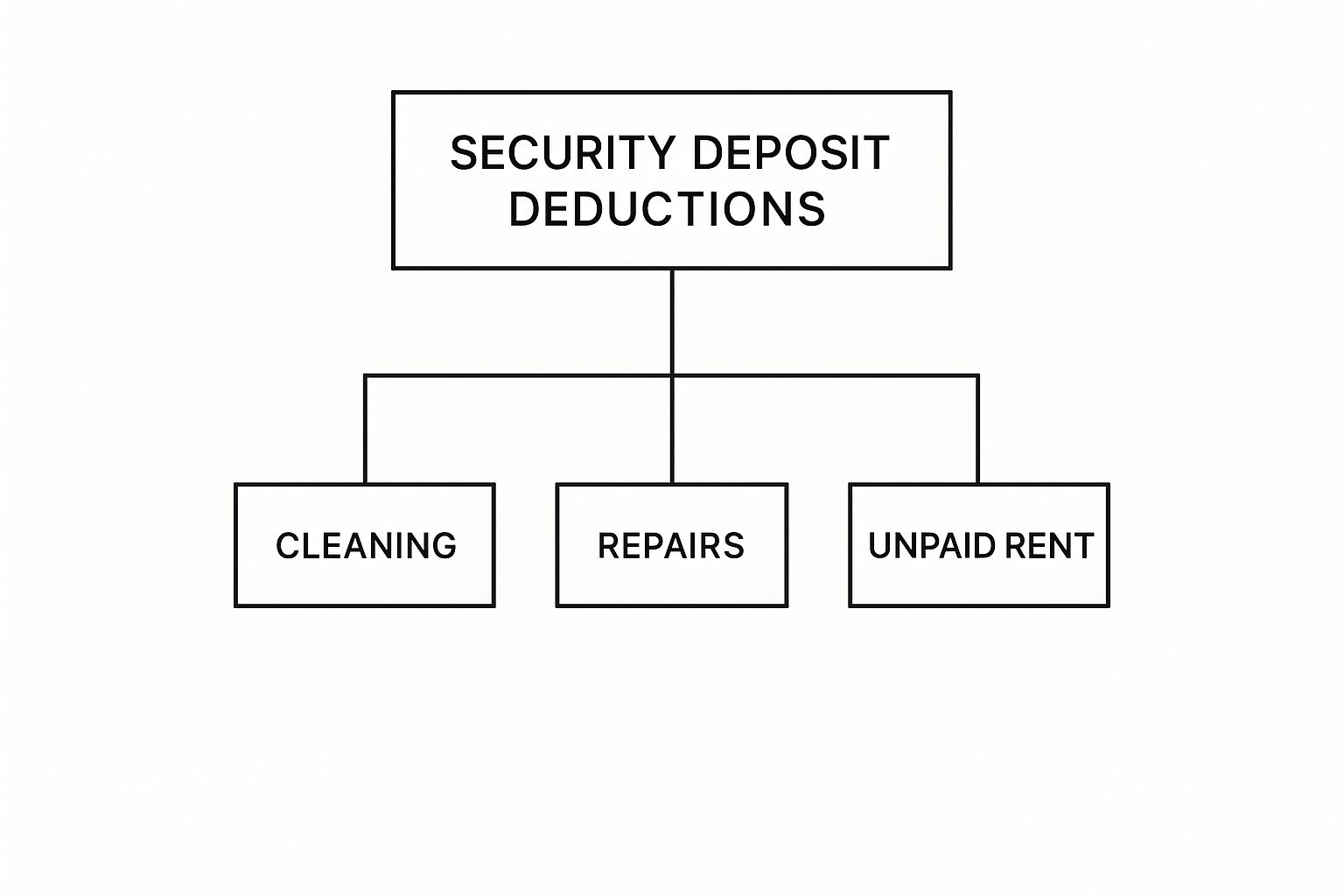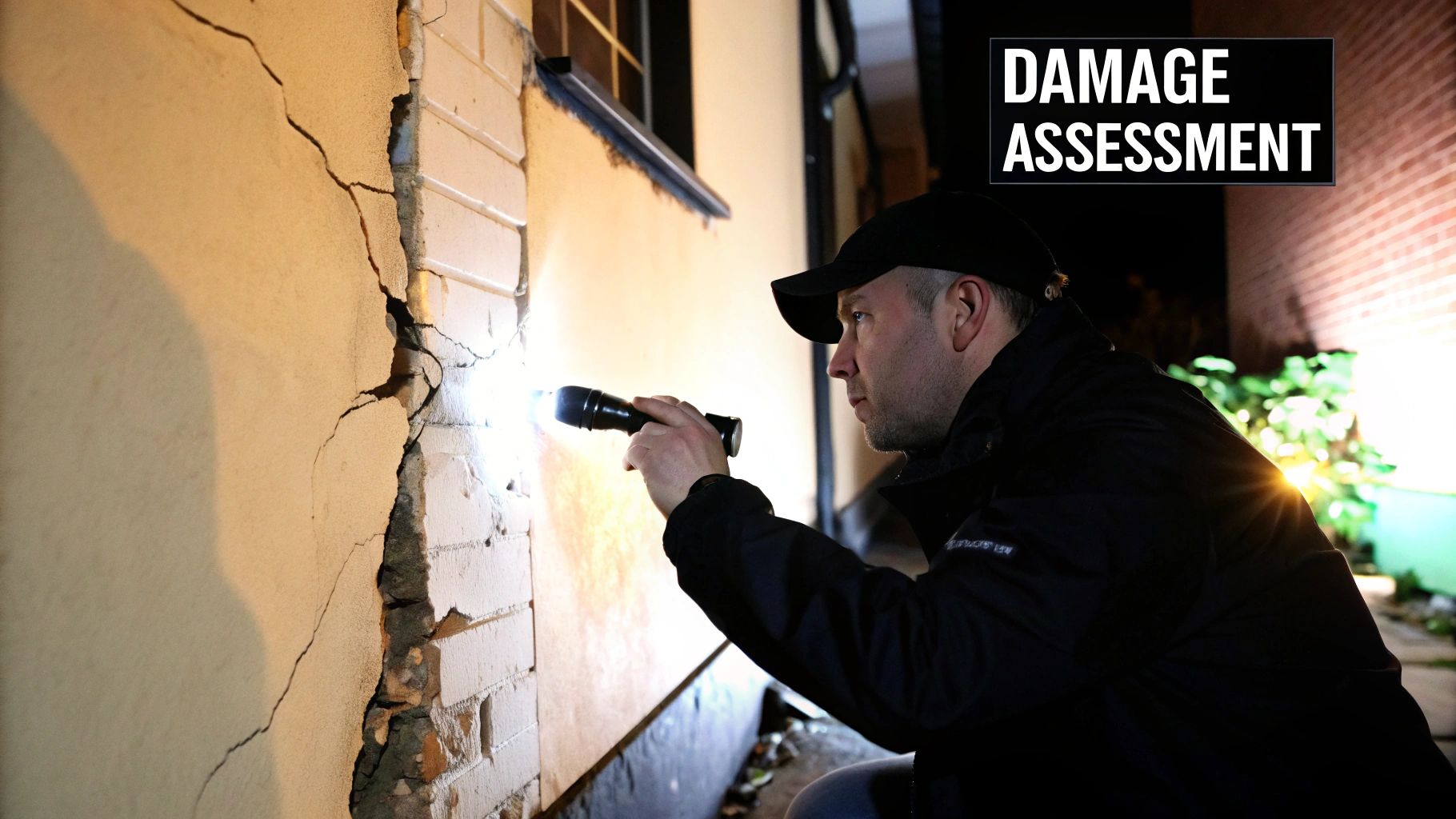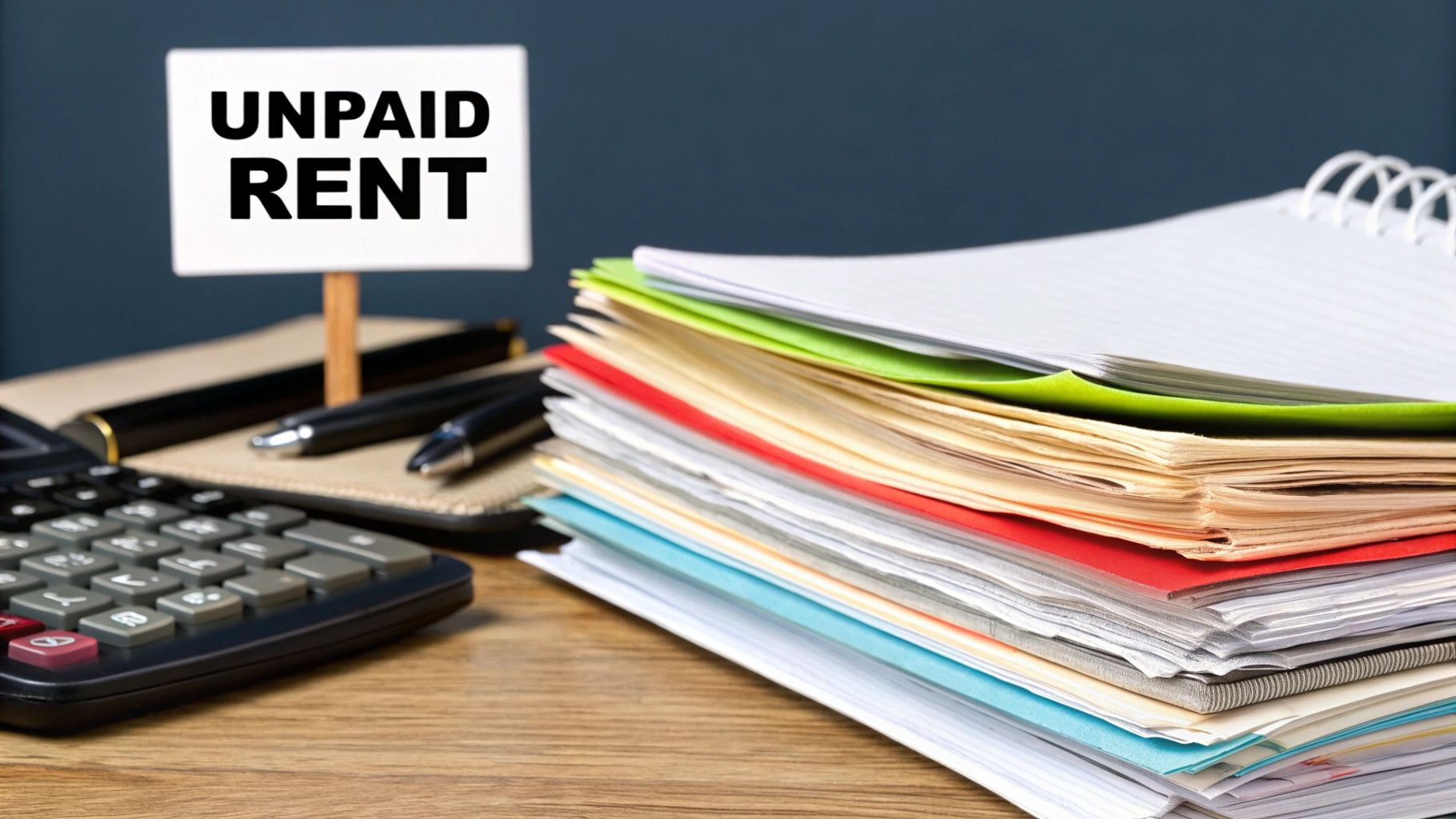What Can a Landlord Deduct from a Security Deposit? Key Rules You Need to Know
- Sarah Porter

- Sep 14
- 13 min read
Updated: Sep 15
When a lease ends, one of the biggest questions for both landlords and tenants is, "What happens to the security deposit?" The answer isn't always simple, but the law provides a clear framework.
Think of a security deposit as a financial safety net for the property owner. It’s not extra profit or a fund for general upgrades. Instead, it’s a specific sum held in trust to cover potential, tenant-caused financial losses. A landlord can legally make deductions for three main reasons: unpaid rent, property damage that goes beyond normal wear and tear, and deep cleaning costs to get the unit back to its original move-in condition.
Decoding Security Deposit Deductions
At its core, a security deposit is a refundable payment designed to make the landlord whole if a tenant doesn't hold up their end of the bargain. Whether that’s failing to pay the last month's rent or leaving the property in a state of disrepair, the deposit is there to cover those specific costs.
The exact rules are governed by state and local laws, but they almost always boil down to the same three core areas. This visual guide breaks down what those categories look like in practice.

As you can see, these pillars—unpaid rent, damage repairs, and necessary cleaning—are the legal foundation for a landlord to withhold any part of a tenant's deposit.
The Three Pillars of Deductions
Getting a handle on these categories is the best way to avoid a dispute down the road. Each one covers a different part of a tenant's responsibilities and comes with its own common pitfalls.
Unpaid Rent: This one is the most clear-cut. If a tenant moves out with an outstanding rent balance, the landlord can use the deposit to cover what's owed. It’s a direct reimbursement for a direct loss.
Property Damage: Here’s where things get tricky, and where most disagreements happen. This covers the cost to fix things that are broken, not just worn out. Think a shattered window, a hole punched in a wall, or a pet-stained carpet that needs replacing—not just a few scuff marks on the paint.
Significant Cleaning Costs: Landlords can't charge for a standard turnover cleaning between tenants. However, if a tenant leaves the property exceptionally dirty—requiring professional services to remove stains, odors, or grime—those intensive cleaning bills can often be deducted.
One of the biggest mistakes landlords make is treating the security deposit like a slush fund for routine maintenance. It is, and always remains, the tenant's money until a legitimate, documented claim is made against it for a specific, tenant-caused loss.
To give you a clearer picture, here’s a quick summary of what landlords can typically deduct from a security deposit.
Allowable Security Deposit Deductions at a Glance
Deduction Category | What It Covers | Real-World Example |
|---|---|---|
Unpaid Rent | Any rent, fees, or other charges that are past due according to the lease agreement. | The tenant moves out but failed to pay the last month's rent of $1,500. |
Property Damage | Repairs for damages that exceed "normal wear and tear." This is anything caused by negligence, abuse, or accident. | A large, deep scratch is gouged into a hardwood floor, requiring a professional to sand and refinish the area. |
Cleaning Costs | The cost of returning the unit to the level of cleanliness it was in at the start of the lease, minus normal dirtiness. | The tenant leaves behind piles of trash, stained carpets, and a grease-caked oven, requiring 8 hours of professional cleaning. |
Understanding these fundamental principles helps everyone navigate the move-out process more smoothly. Of course, the real challenge often lies in distinguishing what's considered acceptable "wear and tear" from actual, deductible "damage." That's the gray area we'll explore next.
Normal Wear and Tear vs. Actual Property Damage

This is it. The single most common flashpoint for security deposit disputes. Why? Because the line between what's considered "normal" and what's considered "damage" can feel incredibly blurry and subjective.
So, let's clear it up.
Think of "wear and tear" as the gentle, unavoidable aging process that happens when someone actually lives in a home. It's the natural result of day-to-day use. "Damage," on the other hand, is harm caused by carelessness, accidents, neglect, or outright abuse.
Here’s an analogy: imagine your rental is a brand-new pair of sneakers. After a year of walking, you’d expect some minor scuffs on the soles, slightly faded color from the sun, and maybe some light creasing. That’s normal wear and tear, and a landlord can't charge you for it. It's just a cost of doing business.
But what if those sneakers have a heel snapped off from prying something open, or a giant, fresh stain from spilling a can of paint on them? That's actual damage. In a rental, this looks like a large hole punched in the wall, a cracked window, or a dark wine stain that soaked through the carpet into the padding below.
Identifying the Difference in Practice
Telling these two apart in the real world really just comes down to common sense. Landlords across the United States can deduct for damages that go beyond normal wear and tear, but they can't legally charge a tenant for the property's natural aging process.
Let's break it down with some practical examples:
Paint: A few small nail holes from hanging pictures, minor scuffs from furniture, and slightly faded paint are almost always wear and tear. A wall your tenant decided to paint bright purple without permission, or one covered in crayon murals? That’s damage.
Flooring: Carpets that look a little flattened from foot traffic or hardwood floors with faint surface scratches are normal. But deep gouges from dragging heavy furniture, large pet stains, or cigarette burns are clearly damage.
Fixtures: A cabinet handle that's become a bit loose over time or a toilet flapper that's worn out is wear and tear. A shattered bathroom mirror, a chipped countertop, or a cracked toilet seat is damage.
Here's a great question to ask yourself: Did this happen just from someone living in the space, or did it happen because of a specific, preventable event? Your answer will usually point you in the right direction.
The Power of Inspections and Documentation
Want to avoid arguments over the property's condition altogether? The secret is meticulous documentation from both the landlord and the tenant. A detailed move-in inspection report, packed with dated photos and even videos, creates a clear starting point. It’s your baseline.
When the lease is up, a final walk-through lets everyone compare the property's current state directly against that initial report. This process makes it incredibly simple to spot what’s new and decide if it falls into the wear and tear or damage category. For landlords, a systematic approach is key, which is why we put together a complete landlord's guide to rental property inspections.
When you document everything clearly, you're not dealing with fuzzy memories or opinions anymore. You have objective evidence, and that makes the entire security deposit process transparent and fair for everyone involved.
Covering Unpaid Rent and Financial Obligations

Aside from fixing physical damages, the security deposit is your landlord’s main financial safety net. Of all the reasons a landlord might dip into a deposit, covering unpaid rent is easily the most clear-cut.
If a tenant leaves owing a month's rent, the landlord can legally take that exact amount from the deposit to make themselves whole. There's really no ambiguity here; it's a direct reimbursement for a documented financial loss. This practice protects the property owner’s income and ensures the tenant’s final obligations are settled.
But unpaid rent isn’t the only financial gap a deposit can fill. Your lease agreement is the roadmap here, spelling out all the financial duties you agreed to.
Beyond the Monthly Rent Check
Many leases have specific clauses that make tenants responsible for other costs. If you move out and leave these bills unpaid, the landlord can often use the security deposit to cover them.
Here are a few of the most common financial obligations that can lead to deductions:
Unpaid Utility Bills: If your lease says you're on the hook for water, gas, or electricity and you leave a balance, the landlord can often deduct it. This is especially true if the utility company can hold the property owner responsible for the bill.
Lease Break Fees: It's common for leases to include a specific fee for ending the contract early. If you break the lease without a formal agreement, the landlord can usually deduct this fee.
Late Fees: Did you rack up late fees on rent payments? If they're clearly outlined in your rental agreement and still unpaid, they can be taken from the deposit, too.
Think of the security deposit as the final reconciliation of your financial account with the landlord. The goal is to make sure that when you return the keys, you leave with a zero balance, covering all rent, fees, and bills you agreed to pay.
How These Deductions Work in Practice
Let’s walk through a quick, real-world scenario. Imagine a tenant paid a $2,000 security deposit. They move out but never paid their last month's rent of $1,800.
On top of that, they left an unpaid water bill of $75 that the landlord is now responsible for.
In this situation, the landlord can legally deduct a total of $1,875 ($1,800 for rent + $75 for the utility bill). They would then have to return the remaining $125 to the tenant, along with an itemized statement explaining exactly why those funds were kept. It's a straightforward accounting of all outstanding debts.
When Can a Landlord Deduct for Cleaning Costs?

The whole idea of a "cleaning fee" can be a real point of contention between landlords and tenants. Let's clear the air: a landlord can't just automatically deduct for a standard cleaning service between every tenant. That’s just part of the cost of turning over a rental, like advertising the unit.
So, when can you deduct for cleaning? It all comes down to one simple question: did the tenant leave the property significantly dirtier than they found it? The law isn't looking for perfection. The goal is to get the unit back to its original state of cleanliness, minus the inevitable wear and tear of daily life.
Defining "Significantly Dirtier"
We're not talking about a little dust on the fan blades or a few crumbs in a kitchen drawer. Legitimate cleaning deductions are for messes that go far beyond a simple wipe-down and vacuum. Think of it as the difference between a quick tidy-up and a full-blown restoration project.
Here are a few real-world scenarios where a deduction is almost always justified:
Heavy Grime Buildup: Imagine an oven caked with months of burnt-on food or a shower stall with such severe soap scum and mildew that it needs professional-grade chemicals to remove.
Abandoned Property and Trash: If a tenant moves out and leaves behind bags of garbage, old furniture, or other personal items, the landlord can absolutely deduct the cost of hauling it all away.
Intensive Carpet Cleaning: A little bit of matting in high-traffic areas is normal. But deep-set stains from pets, red wine spills, or ground-in dirt often require professional shampooing or steam cleaning to restore.
Lingering Odors: Pervasive smells from things like cigarette smoke or pets can seep into carpets, drapes, and even the paint. The cost of specialized treatments to neutralize these odors is a fair deduction.
The Move-In Condition Is Your Baseline
The secret to avoiding arguments over cleaning charges is establishing a clear baseline from day one. This is why a thorough move-in checklist, complete with photos or video, is non-negotiable. It creates a documented record of the property's condition that both you and the tenant agree on.
Without that starting point, figuring out what counts as "excessively dirty" becomes a he-said, she-said situation. And those rarely end well for anyone.
A tenant's job isn't to leave the property in brand-new, sparkling condition. Their responsibility is to return it in the same state they received it, often called a "broom-clean" condition. This means sweeping the floors, wiping down surfaces, and not leaving any trash behind.
The best way to protect everyone is to have a rock-solid process. Using a guide like the ultimate move-in and move-out checklist gives both parties a clear framework. This documentation acts as your proof, protecting tenants from unfair fees while giving landlords the evidence they need to justify legitimate cleaning deductions.
Why Documentation Is Your Best Defense
When it comes to a security deposit dispute, the winner is almost always the person with the better records. It’s that simple.
Think of documentation as your objective witness. It cuts through the emotion and guesswork, creating a clear, factual story of the tenancy from move-in to move-out. Without it, you're left with a frustrating “he said, she said” stalemate where nobody wins.
A solid paper trail isn't about looking for a fight; it's about preventing one in the first place.
For tenants, this starts the moment you get the keys. Get your phone out and take detailed photos and videos of everything. Document every scuff, stain, or leaky faucet on your move-in checklist. When you move out, do the exact same thing to prove you left the place in great shape.
For landlords, the burden of proof is even higher. You can't just subtract money from a deposit. You have to provide a detailed, itemized list of every single deduction, backed up by receipts or professional estimates for the work. Saying you spent $200 on "carpet cleaning" won't fly in court. You need the actual invoice from the cleaning company to justify that specific amount.
Creating a Bulletproof Paper Trail
Proper record-keeping is a non-negotiable part of the rental game. It ensures everyone is on the same page and protects both sides from unfair claims. This isn't just a local quirk; it's a global standard. In France, for example, a formal inspection comparing the property's condition at move-out to its state at move-in is mandatory before any deductions are even considered.
The core principle is simple: if you can't prove it, you can't claim it. A landlord without receipts is going to have a tough time defending their deductions. Likewise, a tenant without move-in photos will struggle to prove that a crack in the tile was already there.
Good documentation turns subjective opinions into cold, hard facts. Here’s what every landlord and tenant should have in their file:
The Signed Lease Agreement: This is the rulebook for the entire tenancy.
Move-In/Move-Out Checklists: These forms, signed by both parties, are a before-and-after snapshot of the property's condition.
Dated Photos and Videos: Visual evidence is incredibly persuasive. Get clear shots of every room, appliance, and any existing damage.
Written Communication: Save all emails, letters, and even text messages about repairs, property condition, or rent payments.
Receipts and Invoices: This is non-negotiable for landlords. Keep every single receipt for cleaning services, repairs, or materials needed to justify deductions.
For property owners, mastering meticulous record-keeping isn't just good business—it's your best legal shield. When you document everything, you create a transparent process that builds trust and dramatically reduces the risk of a messy, expensive dispute.
How State Laws Dictate Deposit Returns
Knowing what you can legally deduct from a security deposit is only half the picture. The other, and arguably more critical, half is dictated entirely by your state and sometimes even local laws. These regulations aren't just guidelines; they're the hard-and-fast rules for handling and returning a tenant's deposit.
Think of it this way: federal guidance might provide a general outline, but your state law provides the specific, non-negotiable instructions. One state might require you to return a deposit within 14 days, while a neighboring state could give you up to 45 days. Missing that deadline can have serious financial consequences, often forcing a landlord to pay back double or even triple the original deposit as a penalty.
These laws create the framework you absolutely must operate within. There's no room for interpretation.
Key Differences in State Regulations
The differences from one state to the next can be pretty stark. They affect everything from the maximum amount you can collect upfront to the exact format you must use to document any deductions. A landlord managing a property in Wisconsin plays by a completely different rulebook than one in New Jersey.
Here are a few common areas where you’ll see major variations:
Maximum Deposit Amount: Many states put a ceiling on how much you can ask for. New Jersey, for instance, caps the security deposit at one and a half times the monthly rent. Other states have no limit at all.
Return Deadlines: This is a big one. States set a firm timeline for returning the deposit and an itemized list of deductions. This window typically ranges from 14 to 60 days after the tenant moves out.
Interest Payments: In some states, you can't just let the deposit sit in a standard checking account. You may be required to place it in an interest-bearing account and return that interest to the tenant.
Penalties for Non-Compliance: The consequences for getting this wrong can be steep. Many states give tenants the right to sue for several times the amount of a wrongfully withheld deposit, plus court costs.
The most important thing to remember is this: your lease agreement can never override state law. If you put a clause in your lease that contradicts local regulations, that clause is completely unenforceable in court.
To give you a real-world sense of how much these rules can differ, let's look at a few examples.
State-Specific Security Deposit Laws (Examples)
This table shows just how different the requirements can be, highlighting why you have to know your local laws inside and out.
State | Maximum Security Deposit | Deadline to Return Deposit |
|---|---|---|
California | 2 months' rent (unfurnished) | 21 calendar days |
Texas | No statewide limit | 30 calendar days |
New York | 1 month's rent | 14 days |
Florida | No statewide limit | 15 to 60 days |
As you can see, what’s standard practice in Texas would be illegal in New York.
At the end of the day, being intimately familiar with your local landlord-tenant laws isn't just a good idea—it's an absolute necessity. It’s the only way to handle deposit returns correctly and protect yourself from costly legal disputes.
Answering Common Questions About Deposit Deductions
Even when you know the rules, real-life situations can get tricky. Let's tackle some of the most common questions that pop up for both landlords and tenants when it comes to security deposit deductions.
Can a landlord charge me to repaint the entire apartment?
In most cases, the answer is no. A fresh coat of paint between tenants to cover up minor scuffs from a few years of living is just part of the business. That falls squarely under normal wear and tear, which is the landlord's financial responsibility.
But there are exceptions. Let's say you painted a bedroom a deep, dramatic navy blue without permission. Now, the landlord needs extra primer and labor to get that wall back to a neutral color. In that scenario, they could probably deduct the cost to restore that specific room. The same logic applies if you leave behind excessive crayon art from your kids or a dozen large holes from a poorly mounted TV.
I disagree with the deductions. What's my first step?
Always start with written communication. Your first move should be to send a formal dispute letter to your landlord. Don't just email it—send it via certified mail so you have a receipt proving it was delivered. This paper trail is incredibly important.
In your letter, be specific. List exactly which charges you're contesting and clearly explain why you believe they're unfair. Reference your move-in photos and any other evidence you have. If the landlord doesn't respond or refuses to budge, your next stop is typically small claims court.
A quick but important note: In virtually every state, a landlord cannot legally call a security deposit "non-refundable." It's your money being held in trust, and it must be returned unless there are legitimate, documented reasons not to.
Now, a landlord can charge separate, clearly labeled non-refundable fees (like a one-time pet fee), but that's a different bucket of money entirely. Always check your local and state laws, as they lay out exactly how these funds can be collected, used, and returned.
Handling security deposits correctly comes down to knowing the law and paying close attention to the details. With over 20 years of experience, Keshman Property Management navigates these rules to manage the process fairly and efficiently, protecting your investment while keeping everything above board. You can learn more about our transparent, owner-focused services at https://mypropertymanaged.com.

Comments